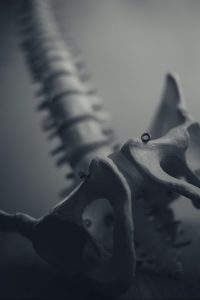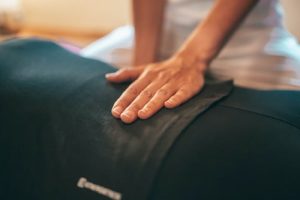Postpartum pelvic physiotherapy

What is postpartum pelvic physiotherapy? This type of specialized physiotherapy treatment helps women who have gone through pregnancy and childbirth. During pregnancy, there can weakening of pelvic floor muscles. Additionally, childbirth can lead to overstretching or injury to the pelvic floor muscles. These changes can lead to pelvic floor dysfunction. Consequently, women may experience several pelvic floor problems as a result of these changes. Postpartum pelvic floor physiotherapy helps women with the healing and strengthening of the pelvic floor muscles after a pregnancy.
What is the pelvic floor?

The pelvic floor refers to a group of muscles found in the base of the pelvis. Most importantly, the pelvic area of the body is the home to organs like the bladder, uterus in women, prostate in men and rectum. The muscles of the pelvic floor support these organs and act as a foundation for their function.
The pelvic floor muscles are often stretched or injured during the process of pregnancy and labour. This may lead to several different issues for women after they have a baby. However, the pelvic floor muscles are like any other muscles of the body. This means that physiotherapy can be an effective treatment option for pelvic floor dysfunctions.
All in all, for more information on pelvic physiotherapy, please visit the Women’s Health Division of the Canadian Physiotherapy Association.
Common postpartum pelvic floor conditions
Urinary incontinence:
- involuntary leakage of urine during daily activities, any strenuous activities, coughing, and/or sneezing
- there may also be a strong urge to pass urine and not able to make it to the toilet.
Bowel incontinence:
- Feces leak involuntarily or there is inability to control the urge to defecate.
Pelvic organ prolapses:
-
- Uterine prolapse: Sensation of heaviness or pulling in the pelvis, vaginal bleeding, uterus protruding out of the vagina, felling like sitting on a ball, urine leakage, problem with sexual intercourse.
- Cystocele: Bladder does not empty completely, feeling of bulge in vagina, difficulty in urinating, stress incontinence.
- Rectocele: Difficulty with completely emptying the bowel
Coccydynia:
Pain in the tailbone area. Pain with sitting on hard surface, can`t sit for longer duration.
Pelvic pain:
Pain in the pelvic area with walking, sharp pain in sitting or dull aches in pelvic area during standing for longer duration, hip or groin pain feeling like uterus pain, pain during sex and pubic pain with physical activity.
Pain during intercourse
Low back pain:
Low back pain while doing certain activities such as bending, lifting, walking, carrying and relieved with rest.
Causes of pelvic floor dysfunction:
Urinary Incontinence
Incontinence is due to the damage caused to pelvic floor muscles, fascia, ligaments and nerves supporting and controlling the bladder. Most importantly, vaginal delivery is a major factor for incontinence problems. Certainly, the delivery process may overstretch the pelvic floor muscles during the pushing phase of delivery or if the baby is too big or heavy. As a result of these changes, urinary incontinence may occur.
Bowel incontinence:
Bowel incontinence is commonly caused by an episiotomy, forceps delivery or perineal tears leading to injury to anal sphincter.
Pelvic organ prolapses:
Pregnancy and vaginal delivery are the common factors leading to the prolapse of the uterus. Other factors include aging and menopause.
Coccydynia:
Injury to the Coccyx (tail bone) can occur during the pushing phase of child birth or with a forceps delivery.
Pelvic pain:
Pelvic pain can happen due to injury to the pudendal nerve or pelvic floor dysfunction.
Pain during intercourse:
Pain during intercourse can occur due to lacerations and tears in the perineal area or episiotomy scar.
Low back pain:
Low back pain after childbirth is often caused by postural changes, diastasis recti, or from stress on the pelvic girdle.
Treatment of Pelvic floor conditions:

Urinary incontinence:
- Stress urinary incontinence is treated with pelvic floor re-education:
- pelvic floor muscle exercises
- pressure biofeedback
- vaginal cones and pelvic floor training
- Urge incontinence or mixed incontinence is treated with:
- biofeedback and pelvic floor muscle training.
To clarify, these techniques will help to teach voluntary control of the pelvic floor muscles which is the key to the treatment of this condition. For example, your therapist will teach you certain positions to empty the bladder properly and give you instructions on using pelvic floor muscles while doing strenuous activities. Pelvic floor muscle training will help to improve the strength of the pelvic floor muscles. Additionally, your therapist will help you to learn the correct pelvic floor muscle contraction by:
-
- assessing the pelvic floor area for proper contractions
- giving you verbal cueing
- biofeedback using electromyography to assess the muscles.
- Bowel incontinence or fecal incontinence: Fecal incontinence is treated through the training of the pelvic floor muscles, volumetric training through rectal balloon catheters, external electrical stimulations and behavioral bowel training.
Pelvic organ prolapses
Pelvic floor muscle training in the correct way can help prevent and treat prolapse of pelvic organs. A good outcome needs proper instructions and close follow up to help recovery. Wearing pessaries will help too. Certainly, your physiotherapist can teach you the use of pessaries as a conservative treatment. Additionally, your physiotherapist will prescribe pelvic floor exercises. These exercises will help to improve the symptoms of prolapse and prevent further descent of the organs in the pelvis.
Coccydynia
Mobilization of coccyx, pelvic floor relaxation and stretches along with ergonomic advice will help to relieve the pain related to the injury to coccyx.
Pelvic pain
Post-natal pelvic pain due to pelvic floor dysfunction is treated through training of pelvic floor muscles.
Pain during intercourse
Stretching of the perineal area, scar mobilization and self-massage techniques will help to treat the pain.
Low back pain:
Low back pain is treated through postural correction, treatment of distastes recti, and pelvic floor relaxation exercises.
In conclusion, having a baby is already a challenging time. Do not let pelvic floor pain add to an already stressful experience. Call PhysioNow today to book an assessment for postpartum pelvic physiotherapy!



Leave a Reply